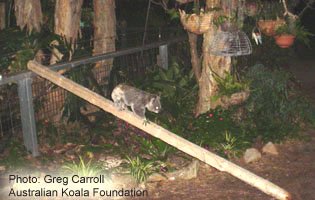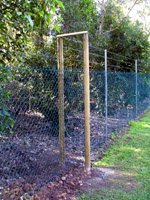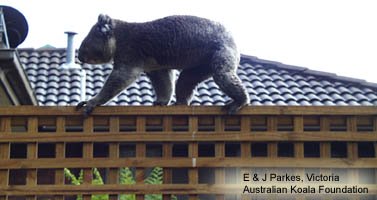VEGETATION
Keep native vegetation on your block, and don’t destroy eucalypts and other native vegetation. As well as being homes for Koalas, they are food, shelter and nesting sites for many other native animals and birds. The hollows in older trees are very important to many animals and they may take hundreds of years to develop. If we destroy all the older established trees, where are these animals going to live and nest until new trees mature to this level?
Find out which types of eucalypts the local Koalas prefer and plant these. Click here for a list of preferred trees for sites already mapped by the Australian Koala Foundation for the Koala Habitat Atlas. Alternatively, talk to your nursery, or to your local Koala group.
Koalas also like to rest in, and sometimes eat, the leaves of other types of native trees. Plant trees along fences and creeklines as linkages to parks and bushland, allowing the Koalas more safety from dogs and cars Do not plant Koala trees in places which would encourage Koalas into danger, such as on main roads, fenced in with swimming pools or close to power lines. Choose trees to suit the soil type and site.
KOALA FRIENDLY FENCES
The presence of dogs and fences mostly do not deter Koalas. They are intent upon locating suitable home trees. If Koalas already use the trees in your yard, then those are likely to be home trees for the Koalas and you should make it as safe as possible for the Koalas to enter your yard. You can do this by erecting a fence which is easily scaled by a Koala. Incorporate trees into the fenceline or place overlapping trees on each side of the fence to form a bridge. Koalas need to be able to continue to move freely across the ground. If they come across a fence they may continue to walk along it until they find a break. They need to be able to escape quickly if a dog is chasing them or if they feel threatened in any way.
1st Option: Best case scenario is to have no fence at all. If there are no dogs allowed on the property then no fence is required. Native vegetation hedges also makes excellent screening and provide habitat for small birds. They also allow unrestricted fauna movement.
2nd Option: At least a 30cm gap should be maintained under the fence. The fence can then be made of any materials as long as the gap allows koalas to move freely underneath it.
3rd Option: Post and bridge system over the fence. The posts allow Koalas to escape from dogs and traffic quickly. Ensure that a post exists every 10 – 20 metres along the fence and that there is also a post on the other side to allow the Koala to get down the other side.


4th Option: Lattice secured firmly to the fence. Ensure there is a full panel every 10 – 20 metres and that the panel extends from the ground to the top of the fence.

Capping on top of the fence may also make it easier for the Koalas to move along the top of the fence out of harms way.
Many acoustic fences are being installed recently which cause a major problem for Koala movement. The 3rd or 4th options above would replace the need for an acoustic barrier.
If you have a dog, encouraging Koalas into your yard when you are not prepared to take precautions with your dog is irresponsible. It may be more humane to deter Koalas from entering your yard altogether by having a Koala-proof fence, with no overhanging trees to allow them access. However, the more trees the Koalas have access to, the better and surely it is worth taking the trouble to be a responsible dog owner to have the priviledge and delight of having the Koalas visit your garden.
SWIMMING POOLS
Although they can swim, some Koalas drown in swimming pools because they often are unable to climb back out if they fall in. If you have a swimming pool, securely tie a sturdy rope to a tree or post at the side of the pool and place the end in the pool. Alternatively, you could ensure that your pool fence is Koala-proof, as well as child-proof.
More ways to keep koalas and other wildlife safe
- Drive slowly and carefully at night. Koalas are nocturnal. Keep to the speed limits.
- Carry a sack, blanket, towel or box in your car, in case you encounter an injured animal when out driving.
- Carry a copy of this information in your car so that you will know what to do if you come across a sick or injured Koala.
- Carry the phone number of your local Koala group or rescue service in your car.
- Inform new and established neighbours about Koalas in the area and make sure they have a copy of this information.
- Also inform your neighbours if a Koala is in the vicinity and suggest they restrain their dogs until the Koala moves off.
- Report any sick, injured or dead Koalas to your local wildlife group or National Parks and Wildlife Service.
- Be careful with garden sprays, pesticides and creosote. Koalas sometimes eat soil, and can also absorb these poisons through the pads on their feet or through eating the leaves of trees which have been affected by chemicals.
- In times of drought or in particularly hot weather, place a container of water for the Koala at the base of a known home tree. (NB: If the tree is in your yard, keep your dog restrained, even during the day)
- Observe Koalas from a distance. Don’t throw things at a Koala to make it move. Wild Koalas become stressed very easily.
- Never try to pat a wild Koala – it’s not as cuddly as it looks! Those sharp claws and teeth can inflict quite a nasty wound.
- Teach your children to love and appreciate all wildlife. Remember, though, it is important to tell them about things they can do to help. Children can become quite depressed if they continually hear negative messages about the environment. Empower them by encouraging them to do some of the things suggested in this brochure, like responsible dog ownership, planting trees and writing letters to newspapers and politicians. Your children can find out great information about Koalas. Koalas for Kids
- Familiarize yourself with your local dog regulations, tree preservation orders, state planning legislation and Endangered Species Act. Adhere to these laws and notify the relevant authority if others contravene them.
- Keep vigilant in your local area about habitat destruction and about the welfare of Koalas. Notify your local wildlife group and the Australian Koala Foundation if you are concerned.
- Write to politicians and newspapers with your concerns. Suggest your council erects signs warning of Koalas crossing roads, improves street lighting etc.
- Join your local Koala or general wildlife group. Support them in their fundraising ventures and ask them how you can help in other ways. Your local Koala group is one of a number of local groups in Australia which are involved in taking care of sick and injured animals and/or being active in keeping an eye on local Koala issues. Most groups rely on volunteers and have to raise their own funds. Please get involved and assist them in any way you can.
- Support the work of the Australian Koala Foundation and especially Save the Koala Month in September each year. The Australian Koala Foundation is the national organisation which funds Koala research, provides educational resources, pushes for the implementation of state and federal laws to protect Koalas and their habitat and co-ordinates the Koala Habitat Atlas, a vital tool in protecting habitat.
The Australian Koala Foundation would like to acknowledge all the wonderful work done by local Koala groups and individuals, and to thank them for sharing their wealth of knowledge on local Koala isuues for the benefit of Koalas in the compiling of this information section.

